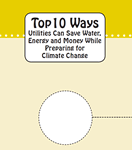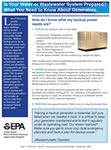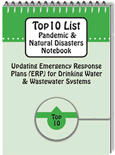All Hazards Emergency Preparedness for Drinking Water Systems
You will need Adobe Reader to view some of the files on this page. See EPA's PDF page to learn more about PDF, and for a link to the free Acrobat Reader.
This page provides links to non-EPA web sites that provide additional information about Emergency Preparedness for Drinking Water Systems. You will leave the EPA.gov domain and enter another page with more information. EPA cannot attest to the accuracy of information on that non-EPA page. Providing links to a non-EPA Web site is not an endorsement of the other site or the information it contains by EPA or any of its employees. Also, be aware that the privacy protection provided on the EPA.gov domain (see Privacy and Security Notice) may not be available at the external link. Exit
During a natural disaster or pandemic emergency, it should be assumed that water systems could have severe shortages in staffing and disruptions in the supply chain. There is also potential for disruption of communications, transportation, services, utilities and public safety. The most important step for water systems is to update their emergency response plans and to evaluate critical functions and how those would be covered in a disaster or pandemic situation.
Useful Tools
- Business Pandemic Checklist
- State & Local Pandemic Checklist
- Schools Pandemic Checklists
- Top 10 Ways Utilities Can Save Water, Energy and Money While Preparing for Climate Change (PDF) (27 pp, 2.2 MB)
- Water/Wastewater System Generator Preparedness brochure (PDF) (6 pp, 978 K)



